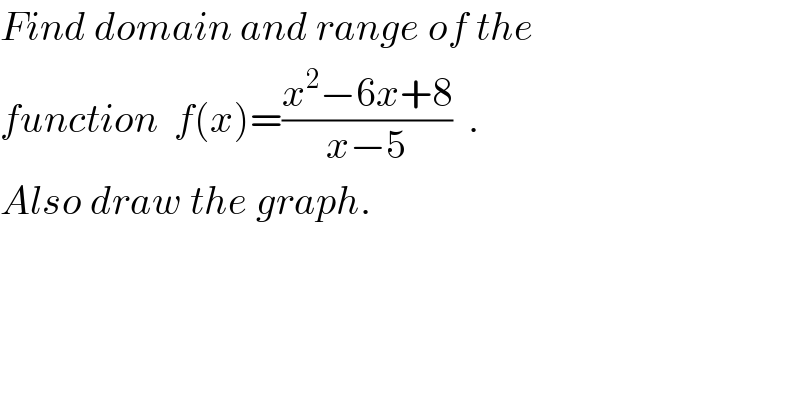
Question and Answers Forum
Question Number 36316 by ajfour last updated on 31/May/18

Answered by tanmay.chaudhury50@gmail.com last updated on 31/May/18
![y=((x^2 −6x+8)/(x−5)) x^2 −6x+8−xy+5y=0 x^2 +x(−6−y)+8+5y=0 discriminant D=B^2 −4AC =(6+y)^2 −4(8+5y) =36+12y+y^2 −32−20y =y^2 −8y+4 =y^2 −2.y.4+(4)^2 +4−16 =(y−4)^2 −(2(√3) )^2 =(y−4)^2 −(2(√3) )^2 =(y−4+2(√3) )(y−4−2(√3) ) critical value of y are(4−2(√3) ),(4+2(√3) ) D>0 when y>4+2(√3) D>0 when y<(4−2(√3) so y can not have value between (4−2(√3) ) and(4+2(√3) ) value of y (−∞,4−2(√3) ] ∪ [4+2(√3),+∞) at x=5 y is undefined so x can not be 5 pls check and suggest domain of x=R−{5}](Q36324.png)
Commented by tanmay.chaudhury50@gmail.com last updated on 31/May/18

Commented by tanmay.chaudhury50@gmail.com last updated on 31/May/18

Answered by ajfour last updated on 31/May/18

Commented by ajfour last updated on 31/May/18
![((df(x))/dx)=(((2x−6)(x−5)−(x^2 −6x+8))/((x−5)^2 )) ⇒ f ′(x)=0 for x^2 −10x+22=0 ⇒ x= ((10±(√(100−88)))/2) =5±(√3) (point of local minima and maxima) f(x)=(((x−2)(x−4))/((x−5))) f(5−(√3))=(((3−(√3))(1−(√3)))/(−(√3))) =((4(√3)−6)/(√3)) = 4−2(√3) f(5+(√3)) = (((3+(√3))(1+(√3)))/(√3)) =4+2(√3) . Domain : x∈ R−{5} Range : f(x) ∈ (−∞, 4−2(√3) ]∪[4+2(√3) ,∞).](Q36327.png)
Answered by ajfour last updated on 31/May/18
![xy−5y=x^2 −6x+8 x^2 −(y+6)x+5y+8=0 for real x (y+6)^2 ≥ 4(5y+8) y^2 −8y+4 ≥ 0 ⇒ roots are y=4±2(√3) ⇒ y ∈ (−∞, 4−2(√3) ]∪[4+2(√3) ,∞).](Q36330.png)
